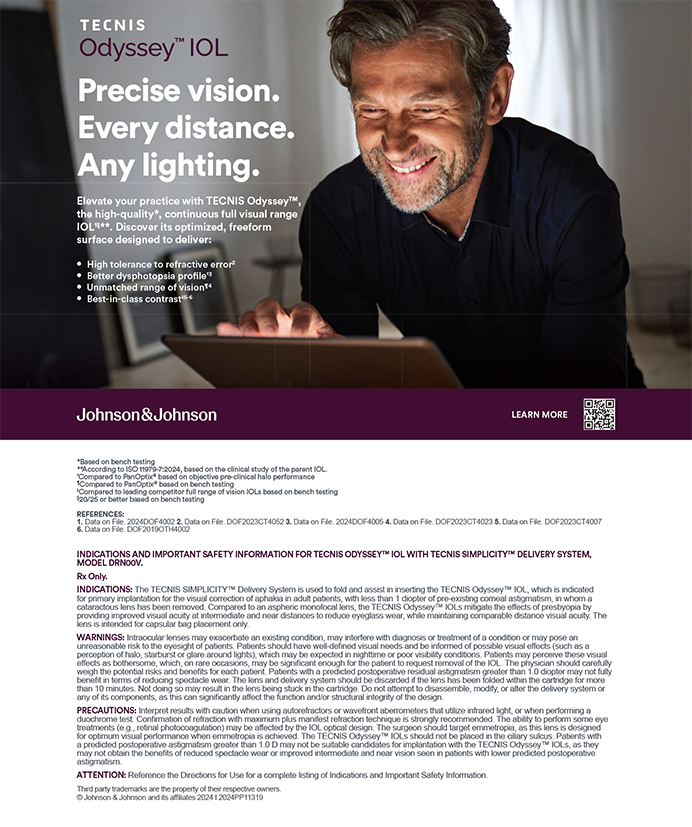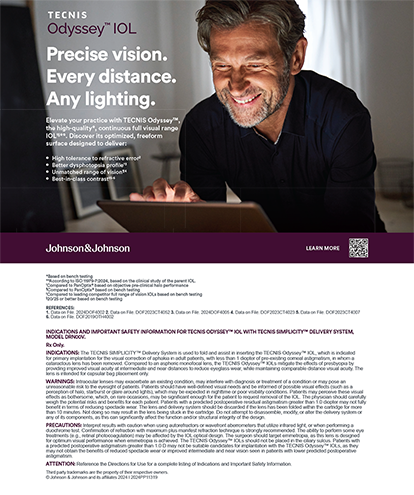

A Comparison of Three Different Corneal Marking Methods Used to Determine Cyclotorsion in the Horizontal Meridian
Lin HY, Fang YT, Chuang YJ, et al1
ABSTRACT SUMMARY
Lin and colleagues performed a retrospective comparison of the Verion Digital Marker (VDM; Alcon) with two manual corneal marking methods (subjective direct visual marking [SDVM] and horizontal slit-beam marking [HSBM]) for the alignment of toric IOLs. The SDVM involved use of a bevel knife tip to mark the horizontal axis temporally while the patient lay supine on the operating table. The HSBM method used the horizontal slit beam on the slit lamp as a guide to mark the horizontal axis at 0º and 180º with a 27-gauge needle while the patient sat upright. The study compared the relative locations of the horizontal meridians from HSBM and SDVM methods to the VDM, which was considered the reference meridian.
AT A GLANCE
- Accurately identifying the reference axis or axis of alignment for toric lenses is critical to maximizing refractive and visual acuity outcomes. A retrospective case series found that horizontal slit-beam marking is superior to subjective direct visual marking for the alignment of these IOLs.
- A prospective randomized case series compared refractive outcomes with a digital “markerless” system (Callisto Eye) to one using intraoperative aberrometry (ORA System with VerifEye+) in patients undergoing cataract surgery and toric IOL implantation. The use of computer-assisted registration resulted in less residual astigmatism than intraoperative aberrometry.
- The studies highlight two emerging beliefs in the minds of refractive cataract surgeons: (1) digitally driven axis determination might be superior to manual marking methods and (2) all digital systems are not necessarily equal in performance, because they are based on a variety of technologies. More studies are needed that compare the varying techniques and technologies to each other and that include visual acuity outcomes as a primary outcome measure.
The investigators found that SDVM had greater average relative cyclotorsion compared to HSBM (-3.46º vs 0.41º). They also reported that the mean average misalignment was significantly greater in the SDVM group than the HSBM group (6.94º vs 3.66º, P < .001). The researchers cited several factors contributing to SDVM’s being less than an ideal method of corneal marking, including the reported 2º to 4º of excyclotorsion that occurs when the patient moves from an upright to a supine position and variability in the placement of markings, possibly dependent upon the handedness of the surgeon.
The researchers concluded that SDVM is not a reliable method of corneal marking. They stated that VDM is reliable and that it is not affected by ink marker washout. HSBM may be a reliable method of corneal marking, but it can be affected by ink marker washout.
DISCUSSION
This retrospective case series provides data showing that HSBM is superior to SDVM for the alignment of toric IOLs. The study is important because accurately identifying the reference axis or axis of alignment for these lenses is critical to maximizing refractive and visual acuity outcomes. Small angle misalignments can translate to significant reductions in corrected astigmatism. A 3.3% reduction in cylinder correction for every 1º that a toric IOL is off axis has been reported.2
By comparing SDVM and HSBM to VDM, the investigators used VDM as their “gold standard.” Although their article supports the contention that digital marking systems may be superior to some manual marking systems, it lacks both refractive and visual acuity outcomes and thus stops short of proving that a particular method optimizes outcomes that matter to patients. It would be useful to know the refractive and visual acuity outcomes of the patients included in this study, specifically the residual cylinder in the postoperative manifest refraction and the uncorrected distance visual acuity.
Manual marking systems have the advantage of being cheaper than their digitally guided counterparts, but for patients paying a premium for toric IOLs, achieving a satisfactory outcome (ie, spectacle independence) is imperative. If digitally guided systems help achieve better outcomes, their use must be carefully weighed against the added costs. The research by Lin and colleagues alone does not warrant the widespread adoption of digitally guided systems, but at least one other study reports that digital marking systems are superior to manual marking.3 Together, these studies suggest that, if a computer-guided system is available to the refractive cataract surgeon, its use may prove beneficial over manual marking alternatives.
Toric Outcomes: Computer-Assisted Registration Versus Intraoperative Aberrometry
Solomon JD, Ladas J4
ABSTRACT SUMMARY
Solomon and Ladas reported on a prospective randomized case series comparing refractive outcomes with a digital “markerless” system (Callisto Eye; Carl Zeiss Meditec) to one using intraoperative aberrometry (ORA System with VerifEye+; Alcon) in patients undergoing cataract surgery and toric IOL implantation. The primary outcome in the study was mean residual postoperative astigmatism.
The investigators found that mean residual postoperative astigmatism in the computer-assisted group was significantly lower than in the intraoperative aberrometry group (0.29 ±0.22 vs 0.46 ±0.25 D, P = .00039). In addition, the percentage of eyes with no remaining postoperative cylinder was three times higher in the computer-assisted group than in the aberrometry group (25.50% vs 8.00%). There was no significant difference between the two methods, however, with regards to median absolute error (0.35 vs 0.39 D, P = .91). The likelihood of achieving residual astigmatism lower than 0.50 D in the aberrometry group was similar to that reported in previously published studies.5
The researchers concluded that the use of computer-assisted registration resulted in less residual astigmatism than intraoperative aberrometry.
DISCUSSION
Solomon and Ladas should be commended on their prospective study, which compares two state-of-the-art technologies head to head in an investigation into whether one might be better suited for the alignment of toric IOLs. The research is important because the devices are based on completely different technologies, and because there are advantages and disadvantages to each. For instance, the Callisto combines scleral vessel registration with biometry data from the eye in its natural state; intuitively, this appears to be a robust method of axis determination. In its current form, however, the IOLMaster 700 (Carl Zeiss Meditec; one of the biometers used with the Callisto) cannot use postoperative refractions to optimize future outcomes. The ORA can use postoperative refractions to improve future outcomes, but it is still unclear whether intraoperative factors such as the position of the lid speculum, IOP, or the presence of retained viscoelastic affect the reliability of measurements and recommendations.
It is interesting to note that the investigators found no difference in the predictive abilities of the two devices (ie, similar median absolute errors); nonetheless, the Callisto still outperformed ORA with respect to refractive outcomes. Although refractive outcomes are important, it would have been interesting to see a head-to-head comparison of the visual acuity outcomes. Because the researchers must have had these data, it is unclear why they were not presented. Ultimately, uncorrected distance visual acuity, not residual refractive error, is what matters most to patients receiving premium IOLs, and follow-up studies that evaluate these technologies should include this additional outcome measure.
1. Lin HY, Fang YT, Chuang YJ, et al. A comparison of three different corneal marking methods used to determine cyclotorsion in the horizontal meridian. Clin Ophthalmol. 2017;8(11):311-315.
2. Hill W, Potvin R. Monte Carlo simulation of expected outcomes with the AcrySof toric intraocular lens. BMC Ophthalmol. 2008;8:22.
3. Elhofi AH, Helaly HA. Comparison between digital and manual marking for toric intraocular lenses: a randomized trial. Medicine (Baltimore). 2015;94(38):e1618.
4. Solomon JD, Ladas J. Toric outcomes: computer-assisted registration versus intraoperative aberrometry. J Cataract Refract Surg. 2017;43(4):498-504.
5. Hatch KM, Woodcock EC, Talamo JH. Intraocular lens power selection and positioning with and without intraoperative aberrometry. J Refract Surg. 2015;31(4):237-242.




